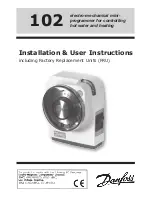
Omega Model CYD211 User’s Manual
Installation 2-5
2.5.3
Shielding Sensor Leads
Shielding the sensor lead cable is important to keep external noise from
entering the measurement. The sensor lead cable should be shielded
whenever possible. In many systems, it is impractical to shield the sensor
leads inside the cryostat. In theses cases, the cable shield should still be
used on the room temperature sensor leads up to the cryostat.
A shield is most effective when it is near the measurement potential, so the
Model CYD211 offers a shield pin on the Input/Output Connector that stays
close to the measurement. The shield pin is tied to chassis ground and
should be used as the connection point for the sensor cable shield.
Depending on how the instrument is grounded, the shield may or may not
need to be terminated at the opposite end. See Section 2.5.4 below on
instrument grounding.
2.5.4 Instrument
Grounding
The Model CYD211 does not provide isolation between measurement
circuits and chassis ground. The measurement leads have a finite impedance
to chassis ground and should not be tied to ground outside the instrument or
an error in reading may result. The Model CYD211 has the best noise
performance when the chassis is tied to earth ground. This connection
should be made at only one point so as to avoid ground loops.
Many power supplies connect the common pins to earth ground. When
using this configuration, it should be the only connection between the
Model CYD211 and earth ground. If the sensor leads are shielded, the cable
shield should be tied to the shield pins on the Input/Output connector but
should not be terminated at the other end.
If the power supply does not connect the common pins to earth ground, the
connection should be made externally. If the sensor leads are shielded, one
end of the cable shield can be tied to the cryostat ground while the other end
is tied to the shield pins on the Input/Output connector. If the sensor leads
are not shielded the instrument chassis should be strapped to earth ground.
















































